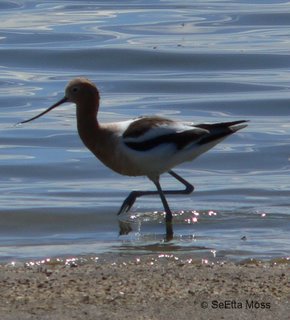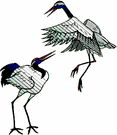
Today I birded some of the many lakes in the lower Arkansas Valley. The weather was quite warm for this early in April, going over 80 degrees. Most of the lakes in this area are irrigation reservoirs so their water levels vary according to how much water the irrigation company is allowed to store and how much has been run out for irrigating the farm fields. However, these are often excellent for shorebird migration in spring as well as drawing many other birds.
I usually stop at the Ordway Feed Lot on my way in to Lake Meredith as the ponds south of it and the ditches by the side of the road can be quite productive. There wasn't a lot here today--2 Lesser Scaup, 1 Cinnamon Teal, some Mallards, a few white-headed gulls (those I checked were Ring-billed), some White-crowned Sparrows in the vegetation and 6-8 Franklin Gulls flying around.
Lake Meredith is a fairly large lake (for Colorado), but much of it is bordered by private farm land and inaccesssible. The State Wildlife Area portion is on the north side and so it is accessed from the town of Ordway. I found 3 Ibis species, 1 Great Egret, 2 Aechmophorus grebes, several American Avocet (including the one in the pic), 1 Greater Yellowlegs and 1 Lesser Yellowlegs around the shore. There were rafts of hundreds of Ruddy Ducks and Northern Shovelers with miscellaneous common waterfowl on the lake.
At nearby Lake Henry, bird action was quite slow for this often very productive lake for shorebirds, waterfowl and other waterbirds. I saw 1 Common Goldeneye, 1 N. Shoveler, 1 Double-crested Cormorant, 2 Mallards and a bunch of Killdeer---that's lean.
Lake Cheraw, another irrigation reservior that is a hot spot especially for shorebird migration, was also pretty slow. I saw 4 American Avocets, some Northern Shovelers, Ruddy Ducks, Green-winged Teal, Coots, and Killdeer.
My last stop was Lake Holbrook which is a close to La Junta. I saw my first Black-necked Stilts (3) of the year. Tehre were at least 4 Greater Yellowlegs and 3 Lesser Yellowlegs, several American Avocet and lots of Killdeer (they nest along the shore which is astounding given all the vehicles that drive around the lake). There were several Pintail Ducks and 1 Cinnamon Teal along with common waterfowl seen at the other lakes.
I saw my first Swainson's Hawk of the year today. Other birds seen included a few Red-tailed Hawks, several American Kestrals, the ubiquitous Horned Larks and 1 Vesper Sparrow (they are just migrating back).
Conspicuously missing today was American White Pelican--they are arriving at northern areas of the state and are always present on these lower Arkansas Valley lakes from spring thru summer.
SeEtta
















